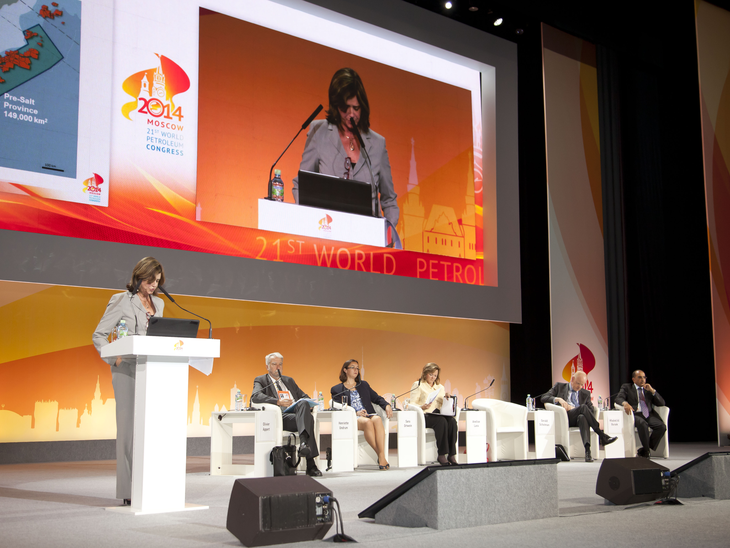Aggregate production from the pre-salt layer reaches 343 million barrels.
Production from the pre-salt layer has already passed the 400,000 barrels of oil per day milestone.
Petrobras Agency20/06/2014 13:02

Photo: Petrobras executive manager describes pre-salt exploration and production scenario. Petrobras exploration manager and Petrobras Biocombustível’s director for Ethanol also give presentations
Production from the pre-salt layer has already passed the 400,000 barrels of oil per day milestone. The level was reached just eight years after the first discovery was made, which is a faster rate of development than any other deep water field around the world. In the Gulf of Mexico, for example, it took 19 years to reach that production level; in the North Sea, nine years; and in Brazil’s Campos Basin it also took 16 years to attain that level. This information was provided by Anelise Lara, Petrobras’ executive manager for the Libra field, during the panel "Deep Water exploration and production", at the World Petroleum Congress (WPC), in Moscow. Anelise added that, "The accumulated production from the pre-salt layer, between September 2008 and April 2014, attained 343 million barrels of oil and gas equivalent (boe)".
Ms. Lara highlighted the 100% geological success rate in the pre-salt layer as well as the reduced time lag for drilling wells in the region, saying that "When the first well was drilled, in 2006, it took 134 days from the beginning of the well to the last meter drilled. In 2013, the time was down to just 60 days”. She also showed pictures of the nine FPSOs (Floating Production, Storage and Offloading units) that are currently operating in the Brazilian pre-salt layer, adding that, "By 2020 we will have another 24 definitive pre-salt production systems, producing around 2 million barrels of oil per day". The executive manager presented "Challenges and Solutions to Develop Brazilian Pre-Salt Deepwater Fields", prepared together with other employees in Petrobras’ Exploration and Production area.
In another presentation, Petrobras’ Exploration general manager, Jeferson Luiz Dias talked about the company's investments in exploration and production, which will amount to US$ 153.9 billion for the period 2014-2018. Of that total, US$ 23 billion will be allocated to exploration, with 27% (US$ 6.4 billion) going to the pre-salt layer alone. Of the rest, US$ 112.5 billion will be invested in production, with 64% (US$ 71.8 billion) going into pre-salt layer production, while US$ 18 billion will be invested in infrastructure. Mr. dias added that, "Considering Petrobras’ portion, plus the investments of its partners (US$ 44.8 billion), the total spending on exploration and production during that period will come to US$ 198.7 billion, in other words, almost US$ 200 billion".
The general manager also showed the share of pre-salt layer in the Petrobras production curve to 2020. While the pre-salt layer only accounts today for around 16% of the total production of 2.1 million barrels of oil per day, in 2020 this will have grown to 53% of the total production, which by then will be 4.2 million barrels per day. He completed that, "Consequently, the contribution of the pre-salt layer will be decisive for Petrobras to achieve the goals set out in the 2014-2018 Business and Management Plan and its 2030 strategic planning".
Ethanol is a conference highlight
Milas Evangelista, Petrobras Biocombustível’s director for Ethanol, was also present at the WPC and emphasized the benefits of using biofuels to reduce greenhouse gas (GHG) emissions and improve the quality of the air in the larger cities. He added that ethanol derived from sugarcane avoids the emission of 46 million tons of CO2e a year in Brazil and the country has huge potential for increasing its production of ethanol, both through the sustainable expansion of sugarcane plantations and through increased productivity. The quantity of CO2e is a measurement that reveals the amount of GHG emissions (one of the main causes of the greenhouse effect) in terms of their equivalent in CO2.
Mr. Evangelista said that, "Petrobras is investing in the development of new sugarcane varieties and in second-generation ethanol technology, cellulosic ethanol, which will be able to increase production by up to 40%, by using the bagasse".
The director noted that the production growth should be sustained. "The share of biofuels in global road transport fuel demand should rise from the current 3% to 8% in 2035, according to International Energy Agency projections," Mr. Evangelista said, pointing out that several countries have already introduced regulations requiring the use biofuels in their energy matrix. He was participating in the roundtable "Sustainability of biofuels from different feedstocks".



